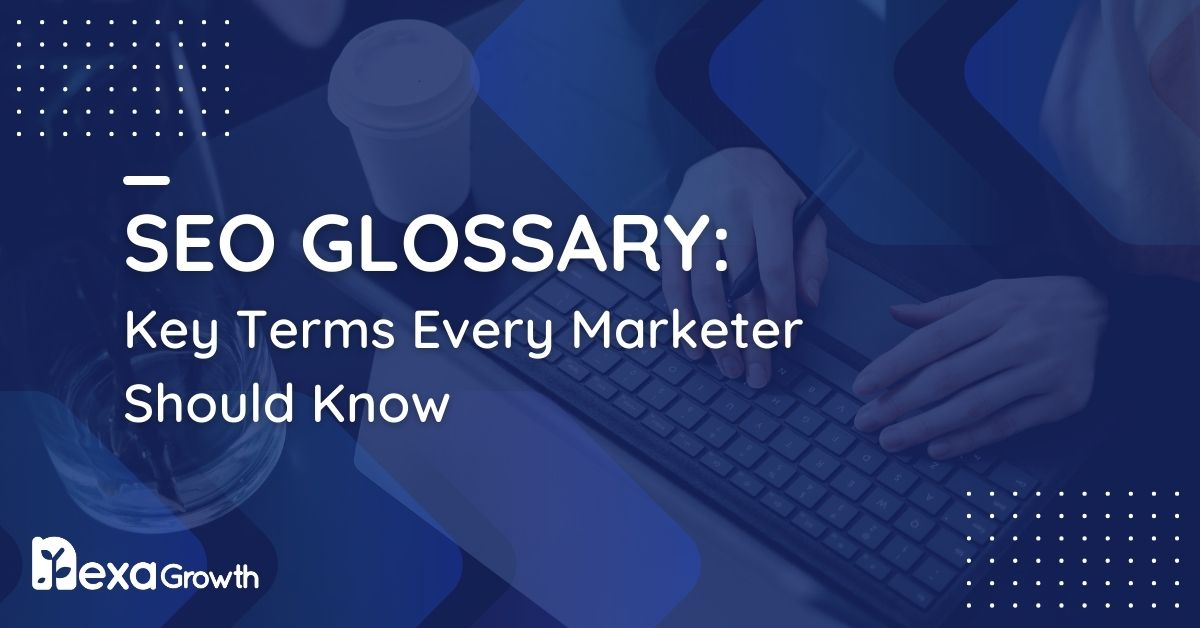- This article provides a comprehensive glossary of essential SEO terms from A-Z.
- The most important terms include SEO, Keywords, Backlinks, SERP, Domain Authority, and PageRank.
- The glossary defines terms like Accelerated Mobile Pages (AMP), Alt Text, Core Web Vitals, and Schema Markup.
- Modern SEO trends are highlighted, emphasizing quality and contextual relevance in link-building.
- The future of content SEO focuses on creating engaging and valuable content for people, not just search engines.
Search Engine Optimization (SEO) is constantly evolving, with new terms and strategies emerging regularly.
This SEO Glossary provides a comprehensive guide to essential SEO terminology, helping beginners and professionals alike stay up-to-date.
SEO That Puts You Ahead
Stay visible, stay competitive, and stay on top with Nexa Growth’s results-driven SEO services. Let’s make it happen!
Contact UsMost Important SEO Terms
If you’re new to SEO, start with these essential terms:
- SEO (Search Engine Optimization) – The process of optimizing websites for higher rankings in search engines.
- Keywords – Words or phrases users search for on Google and other search engines.
- Backlinks – Links from other websites pointing to your site, affecting authority and rankings.
- SERP (Search Engine Results Page) – The page displayed after a search query.
- Domain Authority (DA) – A score predicting a website’s ability to rank.
- PageRank – Google’s algorithm for ranking web pages based on link quality.
- Anchor Text – Clickable text in a hyperlink.
- Meta Tags – HTML tags that provide metadata about a web page.
- Link Building – The process of acquiring backlinks to improve rankings.
- Search Intent – Understanding why a user searches for a specific term.
- Technical SEO – Optimizing the backend of a website for better crawling and indexing.
- Core Web Vitals – Google’s metrics for user experience, including load time, interactivity, and visual stability.
A-Z SEO Glossary
Now, let’s examine all terms related to SEO:
A
- Accelerated Mobile Pages (AMP) – A Google project to speed up mobile pages.
- Algorithm Updates – Changes in search engine algorithms affecting rankings.
- Alt Text – Alternative text for images, improving accessibility and SEO.
- Anchor Text – The clickable text of a hyperlink.
- Article Spinning – Rewriting content automatically, often leading to poor quality.
- Authority Score – A metric measuring a domain’s credibility.
- Auto-Generated Content – AI-created content that lacks human quality control.
B
- Backlinks – Incoming links from other websites.
- Bingbot – Bing’s web crawling bot.
- Black Hat SEO – Unethical SEO tactics that violate search engine guidelines.
- Bounce Rate – The percentage of visitors who leave a site after viewing only one page.
- Branded Keywords – Keywords including a company’s brand name.
- Breadcrumb Navigation – A navigation aid showing a user’s path through a site.
- Broken Link – A hyperlink that leads to a dead or missing page.
C
- Cached Page – A stored version of a webpage used for faster loading.
- Canonical Tag – Tells search engines the preferred version of a duplicate page.
- Content Clusters – A method of grouping related content for better rankings.
- Content Hub – A centralized resource page linking to multiple subpages.
- Cornerstone Content – Foundational content pieces crucial for SEO.
- Crawl Budget – The number of pages search engines will crawl on a site.
- Crawlability – How easily a search engine can crawl a website.
- Customer Journey – The stages a customer goes through before conversion.
- Core Web Vitals – Google’s ranking factors based on user experience.
D
- Dofollow vs. Nofollow Links – Determines whether a link passes authority.
- Domain Rating – A site authority metric used by Ahrefs.
- Doorway Pages – Low-value pages created solely for ranking purposes.
- Duplicate Content – Identical content appearing on multiple URLs.
- Dwell Time – The amount of time users spend on a page before returning to search results.
E
- Editorial Link – A natural backlink from high-quality content.
- Evergreen Content – Content that remains relevant over time.
- Entity-Based SEO – SEO optimized for entities (people, places, things).
- Entry Page – The first page a visitor lands on.
- External Links – Links pointing to another website.
F
- Faceted Navigation – A system that allows users to filter and refine search results on a website.
- Featured Snippets – A summary of an answer to a user’s query, appearing at the top of Google’s search results.
- Footer Links – Links placed in the footer section of a website.
- Freshness Algorithm – A Google algorithm that prioritizes recent content for certain queries.
G
- Google Algorithm – The complex system Google uses to rank web pages.
- Google Analytics – A tool that tracks and reports website traffic and user behavior.
- Google Search Console – A free tool for monitoring a website’s performance in Google Search.
- Googlebot – Google’s web crawler responsible for indexing web pages.
- Guest Blogging – Writing articles for other websites to gain backlinks and exposure.
- Grey Hat SEO – SEO tactics that are borderline unethical but not explicitly penalized.
H
- H1-H6 Tags – HTML tags used to define headings on a webpage.
- Header Tags – Used to structure content hierarchically for better readability and SEO.
- Holistic SEO – An approach that considers all aspects of a website’s performance.
- Hreflang – A tag used to indicate language and regional targeting for a webpage.
- HTTPS & SSL – Security protocols that encrypt website data for safer browsing.
I
- Inbound Links – Links pointing from another website to yours.
- Index Bloat – A situation where a search engine indexes unnecessary pages, affecting site performance.
- Indexing vs. Crawling – The difference between a search engine finding a page (crawling) and storing it in its database (indexing).
- Internal Linking Strategy – A technique to improve site structure and SEO by linking internal pages.
- Informational Query – A search query made to find general information rather than commercial intent.
J
- JavaScript SEO – The practice of optimizing JavaScript-heavy websites for search engines.
- JSON-LD Schema Markup – A structured data format used to enhance search results with rich snippets.
K
- Keyword Clustering – Grouping related keywords to improve content strategy.
- Keyword Difficulty – A metric indicating how hard it is to rank for a specific keyword.
- Keyword Intent – Understanding whether a keyword is informational, navigational, or transactional.
- Keyword Stuffing – Overloading content with keywords in an unnatural way, leading to penalties.
- Long-tail Keywords – Highly specific keyword phrases with lower search volume but higher conversion potential.
- LSI Keywords – Latent Semantic Indexing keywords that relate to the main keyword.
L
- Landing Page – A web page specifically designed to capture user interest and drive conversions.
- Latent Semantic Indexing (LSI) Keywords – Contextually related words and phrases that help search engines understand content relevance.
- Link Bait – High-quality content designed to attract backlinks naturally.
- Link Building – The practice of acquiring inbound links to improve search engine rankings.
- Link Equity – The authority passed from one page to another via hyperlinks.
- Local Business Schema – A structured data markup that helps search engines understand local business details.
- Local Citation – Online mentions of a business’s name, address, and phone number (NAP).
- Local Pack – A Google SERP feature displaying local business listings.
- Local Search Marketing – Strategies used to increase visibility in local search results.
- Local SEO – The process of optimizing a business’s online presence to attract local customers.
M
- Meta Description – A brief summary of a webpage’s content, appearing in search results.
- Meta Keywords – A deprecated HTML tag used for keyword-based rankings.
- Meta Robots Tag – Directives for search engine crawlers on how to index a page.
- Mobile-First Indexing – Google’s practice of using the mobile version of a site for indexing and ranking.
- Mirror Site – A duplicate of an existing site hosted on a different domain or subdomain.
N
- NAP (Name, Address, Phone Number) – Essential information for local SEO citations.
- Negative SEO – Malicious tactics aimed at harming a competitor’s search rankings.
- Nofollow Link – A link attribute instructing search engines not to pass link equity.
- Noindex Tag – A directive preventing search engines from indexing a page.
- Navigational Query – A search intent where users are looking for a specific website.
O
- On-Page SEO – The practice of optimizing individual web pages to rank higher and earn more relevant traffic.
- Open Graph Meta Tags – Tags used to control how a webpage is displayed when shared on social media.
- Organic Search Results – Non-paid search results that appear based on their relevance to a user’s query.
- Organic Traffic – Visitors who land on a website through unpaid search results.
- Orphan Page – A page that is not linked to from anywhere else on a website, making it difficult for search engines to find.
- Outbound Links – Links from your website to external sites.
P
- Page Speed – The time it takes for a webpage to load fully.
- PageRank – Google’s algorithm that evaluates the quality and quantity of backlinks to determine a page’s authority.
- Paid Link – A backlink acquired through monetary transactions rather than natural linking.
- People Also Ask (PAA) – A Google SERP feature displaying related questions and answers.
- Pillar Page – A comprehensive content piece covering a broad topic, linked to related subtopics.
- Pogo-Sticking – When users quickly bounce back and forth between a SERP and different search results, signaling poor content relevance.
- Primary Keyword – The main keyword a page is optimized for.
- Private Blog Network (PBN) – A network of websites used to manipulate search rankings through backlinking.
Q
- Query Deserves Freshness (QDF) – A Google algorithm component that prioritizes fresh content for time-sensitive queries.
- Query Intent – The purpose behind a search query, which can be informational, navigational, or transactional.
R
- RankBrain – Google’s AI-based algorithm that helps process search results.
- Reciprocal Link – A mutual link exchange between two websites.
- Reconsideration Request – A request submitted to Google after fixing violations that led to penalties.
- Related Searches – Alternative search queries suggested by Google.
- Relative URL – A URL that is relative to the domain, rather than including the full path.
- Resource Pages – Pages that compile useful links and information for a particular topic.
- Rich Snippet – An enhanced search result displaying additional data like ratings, prices, or images.
- Robots.txt – A file that instructs search engine crawlers on which pages they can and cannot access.
S
- Schema Markup – Structured data that helps search engines understand webpage content.
- Search Algorithm – The complex system used by search engines to rank web pages.
- Search Engine Poisoning – Malicious tactics used to manipulate search rankings.
- Search Engine Results Pages (SERPs) – The pages displayed by search engines in response to a query.
- Search Intent – The goal or purpose behind a user’s search.
- Search Term – The actual words or phrases typed into a search engine.
- Search Visibility – A metric indicating how often a website appears in search results.
- Secure Sockets Layer (SSL) – A security protocol for encrypting web traffic.
- Seed Keywords – Primary keywords used to generate related search terms.
- SEO Audit – A process of analyzing a website’s search performance and identifying optimization opportunities.
- SEO Silo – A method of structuring a website for better internal linking and relevance.
- SERP Features – Special search result elements such as featured snippets, local packs, and knowledge panels.
- Share of Voice – A metric measuring a website’s visibility compared to competitors.
- Short-Tail Keywords – Broad, high-volume search terms with intense competition.
- Sitelinks – Additional links shown in search results, leading to different sections of a website.
- Sitemaps – A file that helps search engines understand the structure of a website.
- Sitewide Link – A link that appears on every page of a website.
- Spamdexing – The practice of manipulating search rankings using spammy tactics.
- Structured Data – A standardized format for providing information about a webpage to search engines.
- Subdomain – A separate section of a website under the main domain.
T
- Taxonomy SEO – Organizing website content hierarchically to improve search rankings.
- Technical SEO – Optimizing a website’s backend to enhance search engine crawling and indexing.
- TF-IDF (Term Frequency-Inverse Document Frequency) – A metric used to measure keyword relevance.
- Thin Content – Pages with little or no valuable content, which can negatively impact rankings.
- Tiered Link Building – A backlink strategy involving multiple levels of linking.
- Title Tag – An HTML element that defines a webpage’s title in search results.
- Top-Level Domain (TLD) – The last segment of a domain name (e.g., .com, .org, .net).
- Topical Relevance – The degree to which a webpage’s content aligns with a specific subject.
- Transactional Query – A search query indicating an intent to complete a purchase or conversion.
- Transport Layer Security (TLS) – A security protocol that encrypts data over the internet.
- TrustRank – A search engine algorithm that assesses website trustworthiness.
U
- UGC Link Attribute – A rel attribute that identifies user-generated content links.
- Universal Search – A feature where Google blends different types of search results, such as images, videos, and news.
- Unnatural Links – Links that violate Google’s guidelines and can lead to penalties.
- URL Rating (UR) – A metric used by Ahrefs to determine the strength of a URL’s backlink profile.
- URL Slug – The part of a URL that identifies a particular page in a readable format.
- User Intent – The purpose behind a user’s search query.
V
- Vertical Search – Search engines that focus on a specific category, such as images or shopping.
- Voice Search – A technology that allows users to perform searches by speaking.
W
- Website Authority – A measure of how well a site is likely to rank in search engines.
- Website Hit – A request for a file from a web server.
- Website Structure – The organization of a website’s content and navigation.
- Webspam – Techniques that attempt to manipulate search rankings through deceptive practices.
- White-Hat SEO – Ethical SEO practices that follow search engine guidelines.
X, Y, Z – Miscellaneous
- X-Robots-Tag – A directive used in HTTP headers to control search engine crawling.
- YMYL Pages (Your Money, Your Life) – Pages that Google holds to higher quality standards because they impact health, finance, or safety.
# – Numeric SEO Terms
- 10x Content – High-quality content that is ten times better than what is currently ranking.
- 301 Redirect – A permanent redirect from one URL to another, passing SEO value.
- 302 Redirect – A temporary redirect that does not pass SEO value.
- 304 Not Modified – A server response indicating cached content should be used.
- 404 Error – An error message indicating a requested page does not exist.
- 410 Gone – A server response indicating a page has been permanently removed.
Here are expanded sections on SEO Best Practices and SEO Tools & Software, each approximately 1000 words to ensure in-depth coverage.
SEO Best Practices
SEO (Search Engine Optimization) best practices are strategies that help websites rank higher in search engine results pages (SERPs) by improving their structure, content, and user experience.
Following these practices ensures search engines can crawl, index, and rank your website efficiently. Below are some core SEO best practices that will help you optimize your website for better rankings.
-
Mobile Optimization
Google’s mobile-first indexing means that Google predominantly uses the mobile version of your website for indexing and ranking. A non-mobile-friendly website can result in lower rankings and poor user engagement.
How to Optimize for Mobile
- Responsive Design: Ensure your website adjusts seamlessly across different screen sizes.
- Fast Loading Speed: Optimize images, enable compression, and use caching to reduce page load time.
- Avoid Pop-ups: Google penalizes intrusive interstitials that disrupt the user experience.
- Mobile-Friendly Navigation: Keep menus simple and ensure buttons are easy to tap.
-
Page Speed Optimization
Google considers page speed as a ranking factor, and slow websites result in higher bounce rates and lower conversions.
Ways to Improve Page Speed
- Use a Content Delivery Network (CDN): Distribute content across multiple locations.
- Optimize Images: Compress images using tools like TinyPNG or WebP format.
- Minify CSS, JavaScript, and HTML: Remove unnecessary code and spaces.
- Enable Lazy Loading: Load images and videos only when they are about to be viewed.
-
Internal Linking Strategies
Internal linking helps distribute page authority across your website, improves crawlability, and enhances the user experience.
Best Internal Linking Practices
- Use Descriptive Anchor Text: Avoid generic phrases like “click here.”
- Link Deep Pages: Don’t just link to your homepage; link to important pages.
- Keep it Natural: Avoid excessive linking in content.
- Create a Silo Structure: Organize content into relevant clusters to enhance navigation.
-
Image SEO
Optimized images improve page speed, enhance accessibility, and help with Google Image Search rankings.
Best Practices for Image Optimization
- Use Descriptive Filenames: Instead of
IMG123.jpg, usered-running-shoes.jpg. - Add Alt Text: Helps search engines understand the image content.
- Compress Images: Use tools like ShortPixel or TinyPNG to reduce file size.
- Use Structured Data: Implement schema markup for images where relevant.
- Use Descriptive Filenames: Instead of
-
URL Structure
A clean and structured URL improves SEO and user experience.
Best Practices
- Keep it Short & Descriptive: Example:
example.com/seo-tipsinstead ofexample.com/category123/post456 - Use Hyphens, Not Underscores: Google treats hyphens as spaces but underscores as connected words.
- Include Keywords: Keep them relevant but avoid keyword stuffing.
- Avoid Dynamic Parameters: Use readable URLs instead of URLs with
?id=123.
- Keep it Short & Descriptive: Example:
-
User Experience (UX) and SEO
Google’s Core Web Vitals emphasize user experience as a ranking factor.
Core Web Vitals Metrics
- Largest Contentful Paint (LCP): Measures loading speed (should be <2.5 seconds).
- First Input Delay (FID): Measures interactivity (should be <100ms).
- Cumulative Layout Shift (CLS): Measures visual stability.
How to Improve UX for SEO
- Ensure Mobile-Friendliness
- Use Clear CTAs
- Reduce Intrusive Pop-Ups
- Improve Readability with Proper Formatting
Top SEO Tools and Software
SEO tools and software help analyze, track, and optimize websites for better rankings. The right tools can save time, automate tasks, and provide data-driven insights. Here are some of the best SEO tools available for different aspects of SEO.
-
Google Search Console
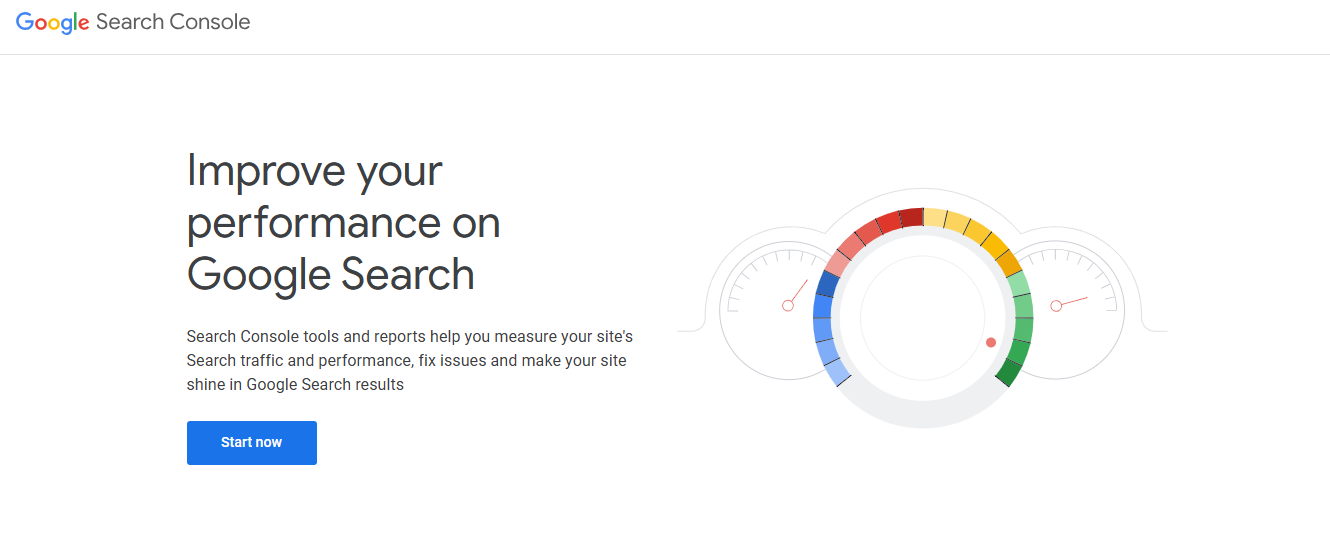
Google Search Console’s Webpage Google Search Console (GSC) is a free tool from Google that helps webmasters monitor website performance, find indexing issues, and improve search visibility.
Key Features
- Indexing Reports: Identify which pages are indexed or have errors.
- Performance Metrics: See clicks, impressions, and CTR.
- Crawl Errors: Find pages Googlebot is struggling to access.
- Sitemap Submission: Help Google discover your pages faster.
-
Google Analytics
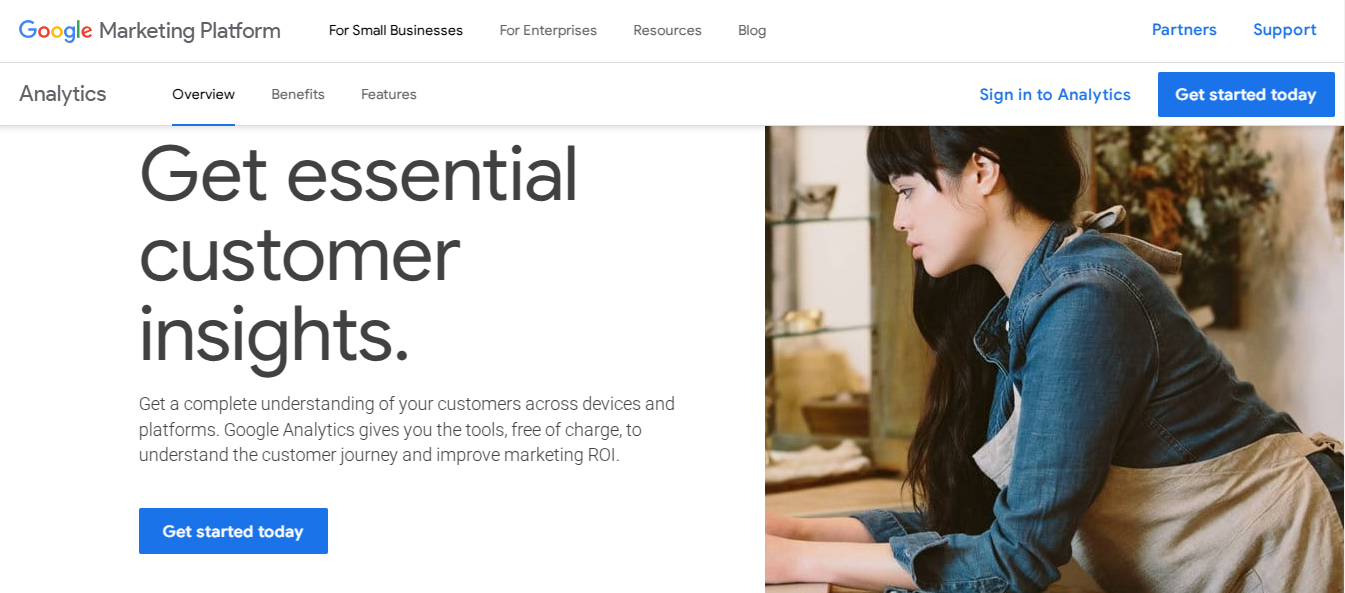
Google Analytics’ Webpage Google Analytics provides deep insights into website traffic, user behavior, and conversions.
Best Features
- Audience Reports: Understand user demographics.
- Behavior Flow: Track how users navigate your site.
- Acquisition Reports: Identify where your traffic comes from (organic, paid, referral).
- Conversion Tracking: Measure goal completions (sign-ups, purchases, etc.).
-
Ahrefs
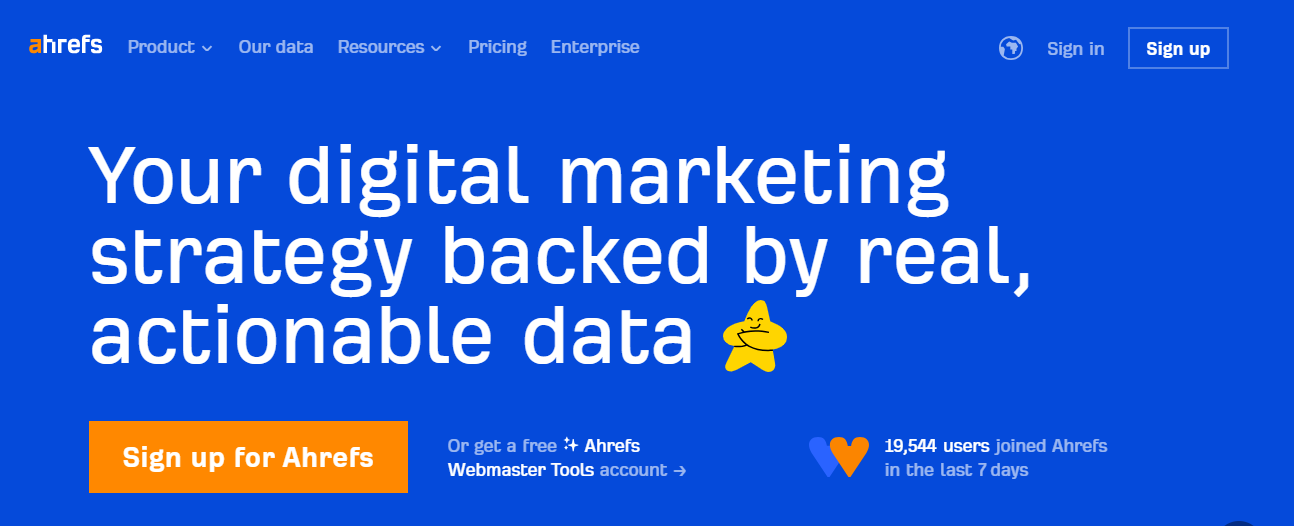
Ahrefs’ Webpage Ahrefs is one of the best SEO backlink analysis tools available.
Key Features
- Site Explorer: Analyze competitors’ backlink profiles.
- Keyword Explorer: Find keyword search volumes and difficulty.
- Site Audit: Detect SEO issues affecting rankings.
- Content Explorer: Discover trending content ideas.
-
Semrush
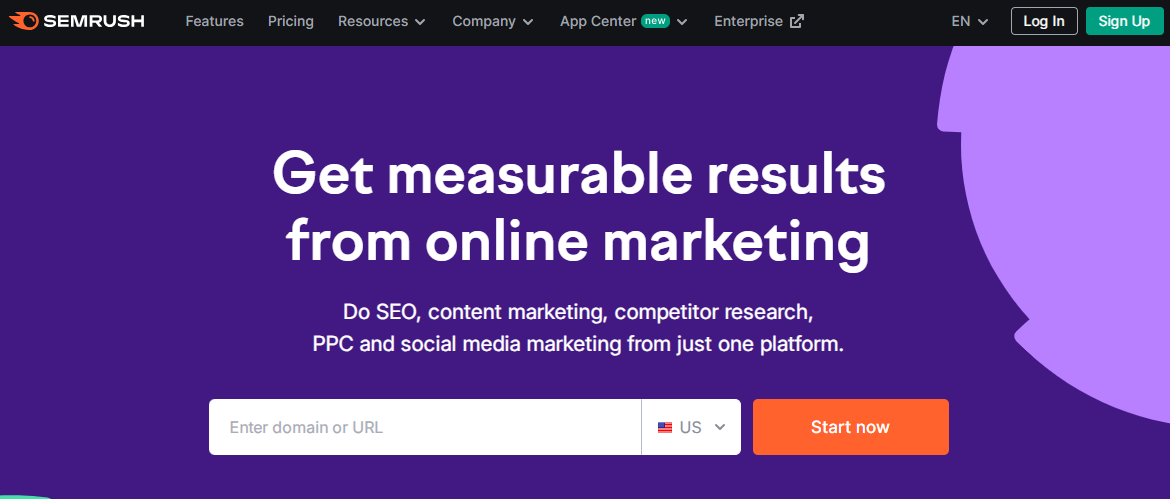
Semrush’s Webpage Semrush is an all-in-one SEO toolkit with features for keyword research, backlink analysis, and competitor tracking.
Best Features
- Keyword Magic Tool: Find the best keywords for your niche.
- Backlink Audit: Analyze the quality of your backlink profile.
- Competitive Analysis: Spy on competitor rankings and traffic sources.
- SEO Content Template: Helps structure SEO-friendly content.
-
Moz Pro
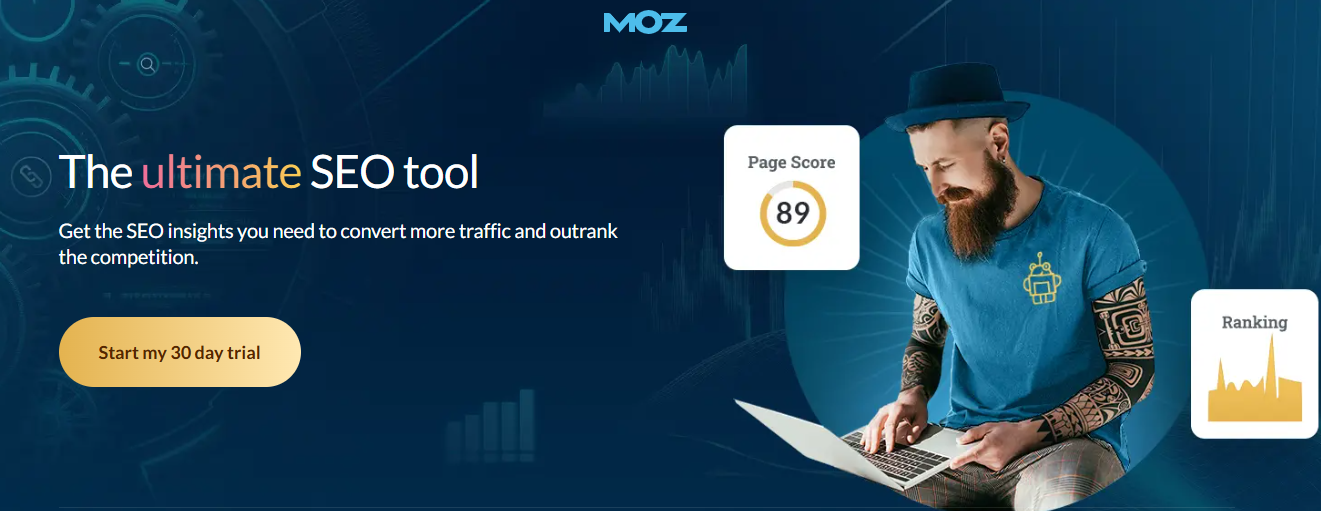
Moz Pro’s Webpage Moz Pro provides a suite of tools that focus on domain authority, keyword tracking, and link building.
Key Features
- Domain Authority (DA) Score: A metric to estimate ranking potential.
- Keyword Explorer: Find new keyword opportunities.
- Link Explorer: Track backlinks and domain authority.
- Site Crawl: Identify technical SEO issues.
-
Screaming Frog

Screaming Frog’s Webpage Screaming Frog is a website crawler that identifies SEO issues quickly and efficiently.
Best Features
- Broken Link Checker
- Redirect Audit
- Metadata Analysis
- Duplicate Content Detection
-
Ubersuggest
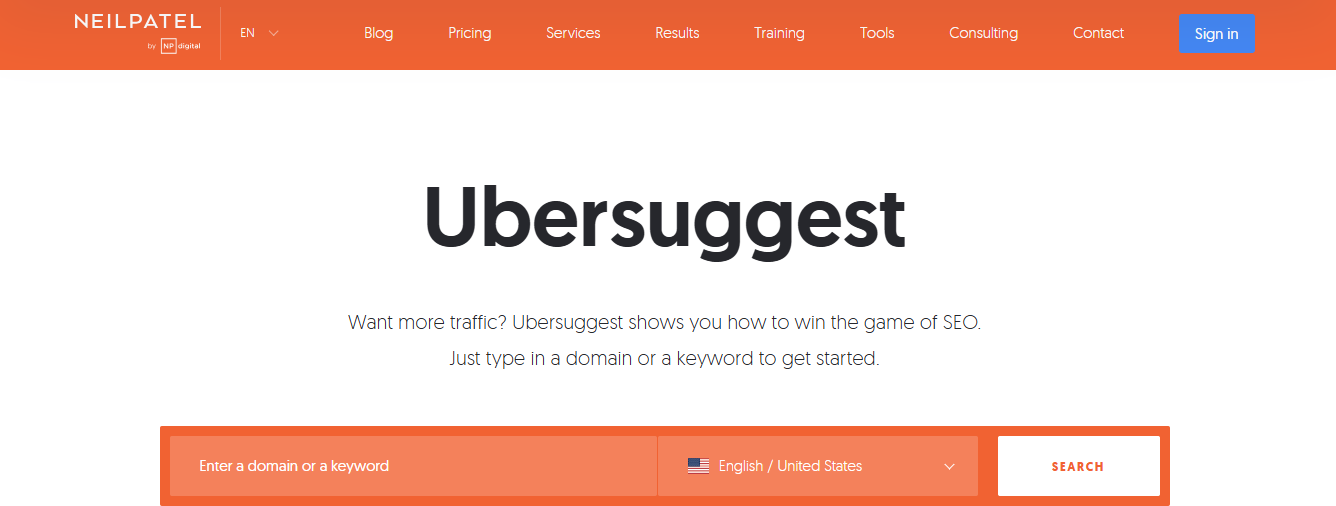
Ubersuggest’s Webpage Ubersuggest is a budget-friendly SEO tool that provides keyword ideas, site audits, and backlink analysis.
Key Features
- Keyword Research
- Content Ideas
- SEO Audit
- Traffic Overview
Future Trends in SEO: What Lies Ahead?
Search Engine Optimization (SEO) is constantly evolving, driven by changes in search engine algorithms, advancements in technology, and shifts in user behavior.
As Google and other search engines become more sophisticated, staying ahead of future trends is essential for businesses, marketers, and website owners.
In this section, we’ll explore the key SEO trends that are shaping the future, ensuring that your strategies remain effective and ahead of the competition.
-
AI and Machine Learning in SEO
Artificial Intelligence (AI) is playing an increasingly critical role in search engine algorithms. Google’s RankBrain and BERT (Bidirectional Encoder Representations from Transformers) are two key AI-driven technologies that improve search results by understanding user intent and natural language.
What This Means for SEO
- Search engines will prioritize context over keywords.
- Long-tail keywords and natural language queries will become more important.
- Optimizing for user intent will be key rather than just keyword density.
How to Adapt
- Focus on semantic search by creating content that answers user queries comprehensively.
- Use conversational keywords that mimic natural speech patterns.
- Optimize content for entities and relationships instead of just exact-match keywords.
-
The Rise of Zero-Click Searches
A zero-click search occurs when a user finds the information they need directly on the Search Engine Results Page (SERP) without clicking on a result. This is often due to:
- Featured Snippets
- Knowledge Panels
- People Also Ask (PAA) boxes
What This Means for SEO
- More searches will end without a website visit.
- Ranking for featured snippets is crucial for visibility.
- Users will engage with quick answers instead of reading full articles.
How to Adapt
- Optimize for Featured Snippets by structuring content with clear headings, bullet points, and concise answers.
- Use schema markup to help Google understand and highlight your content.
- Optimize for voice search since many zero-click searches come from voice assistants.
-
Voice Search and Conversational AI
With the rise of smart assistants like Google Assistant, Alexa, and Siri, voice search is transforming the way people search for information.
How Voice Search Impacts SEO
- Users speak differently than they type (e.g., “best pizza places near me” vs. “where can I get the best pizza?”).
- Local SEO is more important since many voice searches are location-based.
- Google prioritizes quick, clear, and direct answers for voice queries.
How to Optimize for Voice Search
- Focus on conversational keywords and long-tail search phrases.
- Improve your Google Business Profile for better local search rankings.
- Optimize FAQ pages with short, direct answers that align with voice queries.
-
Core Web Vitals and UX as a Ranking Factor
Google’s Core Web Vitals update emphasizes user experience (UX) metrics such as:
- Largest Contentful Paint (LCP) – Measures page load speed.
- First Input Delay (FID) – Measures interactivity.
- Cumulative Layout Shift (CLS) – Measures visual stability.
What This Means for SEO
- Slow-loading websites will drop in rankings.
- User-friendly websites will perform better in search results.
- Bounce rates will affect rankings more significantly.
How to Optimize
- Improve site speed by compressing images, minifying CSS, and using a CDN.
- Enhance mobile experience with responsive design.
- Ensure a stable layout to prevent content from shifting unexpectedly.
-
The Growing Importance of Video SEO
Video consumption is growing rapidly, with platforms like YouTube, TikTok, and Instagram Reels dominating user attention. Google increasingly ranks video content in search results, making Video SEO essential.
How to Optimize for Video SEO
- Use video transcripts to make content searchable.
- Optimize video titles, descriptions, and tags with relevant keywords.
- Embed videos on your website to improve dwell time and engagement.
- Host videos on YouTube since it’s the second-largest search engine.
-
The Impact of Blockchain on SEO
Blockchain, known for its role in cryptocurrency, is also shaping digital marketing and SEO in ways such as:
- Decentralized search engines (like Presearch) that prioritize user privacy.
- Transparent ad tracking to reduce ad fraud.
- More secure backlinks via verifiable transactions.
What This Means for SEO
- New search engines could challenge Google.
- Link-building strategies may shift to blockchain-backed verification.
- Users will have more control over their data and privacy.
How to Prepare
- Stay updated on blockchain-based search engines.
- Monitor changes in link-building and digital advertising.
- Be ready to adapt if blockchain-based search engines gain traction.
-
Entity-Based SEO and Knowledge Graph Optimization
Google now prioritizes entities over traditional keywords, meaning search results are based on relationships between concepts and brands rather than just keyword matches.
What This Means for SEO
- Structured data will be more important.
- Brand identity and authority will impact rankings.
- Google’s Knowledge Graph will play a bigger role.
How to Optimize
- Implement schema markup to define relationships between entities.
- Establish brand authority through citations and mentions.
- Focus on topical authority by covering subjects comprehensively.
-
Evolving Link-Building Strategies
While backlinks remain crucial, Google is shifting towards quality over quantity. Some changes in link-building include:
- Unlinked brand mentions gaining more importance.
- Contextual relevance being prioritized over sheer link numbers.
- Guest blogging evolving to emphasize expertise.
How to Adapt
- Focus on earning links rather than building them manually.
- Engage in public relations (PR) to get natural brand mentions.
- Prioritize relevant, authoritative links rather than spammy ones.
-
The Future of Content SEO
Google’s AI advancements mean that content must be more engaging, helpful, and original than ever before.
Key Content SEO Trends
- Long-form content still dominates, but only if it’s valuable.
- Interactive content (quizzes, polls, calculators) boosts engagement.
- Personalized content tailored to user preferences is gaining importance.
How to Optimize for the Future
- Write for people, not just search engines.
- Leverage AI tools for topic research but ensure originality.
- Create comprehensive, evergreen content that answers user intent.
Conclusion
SEO success is not just about knowing the terms but applying them strategically to your website and marketing efforts.
Whether you’re an SEO beginner or a seasoned professional, keeping up with the latest industry changes will ensure long-term growth and visibility.
Are you ready to take your SEO knowledge to the next level? Bookmark this glossary and refer to it whenever you need a refresher on the latest SEO concepts
Optimize. Rank. Grow.
Your journey to better visibility starts with Nexa Growth. Get the SEO strategy your business deserves!
Contact UsFAQs
1. What is an SEO Glossary and why is it important?
An SEO Glossary is a collection of key search engine optimization (SEO) terms and definitions that help marketers, website owners, and content creators understand SEO jargon. It is important because it:
- Simplifies complex SEO concepts for beginners.
- Helps marketers stay updated on SEO trends and best practices.
- Improves communication among SEO professionals by providing standardized definitions.
- Assists in implementing SEO strategies more effectively.
2. How often should I update my knowledge of SEO terms?
SEO is an ever-evolving field, with Google algorithm updates, AI advancements, and new SEO strategies emerging regularly. It’s recommended to:
- Stay updated monthly by following Google Search Central, SEO blogs (Moz, Ahrefs, SEMrush), and industry experts.
- Regularly review an SEO glossary to ensure you’re using the latest best practices.
- Adapt your SEO strategy based on new ranking factors and trends.
3. What are the most important SEO terms I should know?
Some of the most essential SEO terms every marketer should understand include:
- Keywords – Words or phrases users search for in search engines.
- Backlinks – Links from other websites pointing to your site, improving authority.
- SERP (Search Engine Results Page) – The page that displays search results.
- Domain Authority (DA) – A ranking score that predicts website strength.
- Core Web Vitals – Google’s ranking factors related to page speed, interactivity, and stability.
4. How can I use an SEO glossary to improve my website’s rankings?
An SEO glossary helps improve rankings by:
- Enhancing content quality – Knowing the right SEO terms ensures proper optimization.
- Improving keyword strategy – Understanding terms like long-tail keywords, LSI keywords, and search intent leads to better keyword targeting.
- Boosting technical SEO – Terms like schema markup, crawlability, and canonical tags help improve site structure.
- Strengthening link-building efforts – Learning about anchor text, nofollow links, and link equity helps in acquiring high-quality backlinks.

